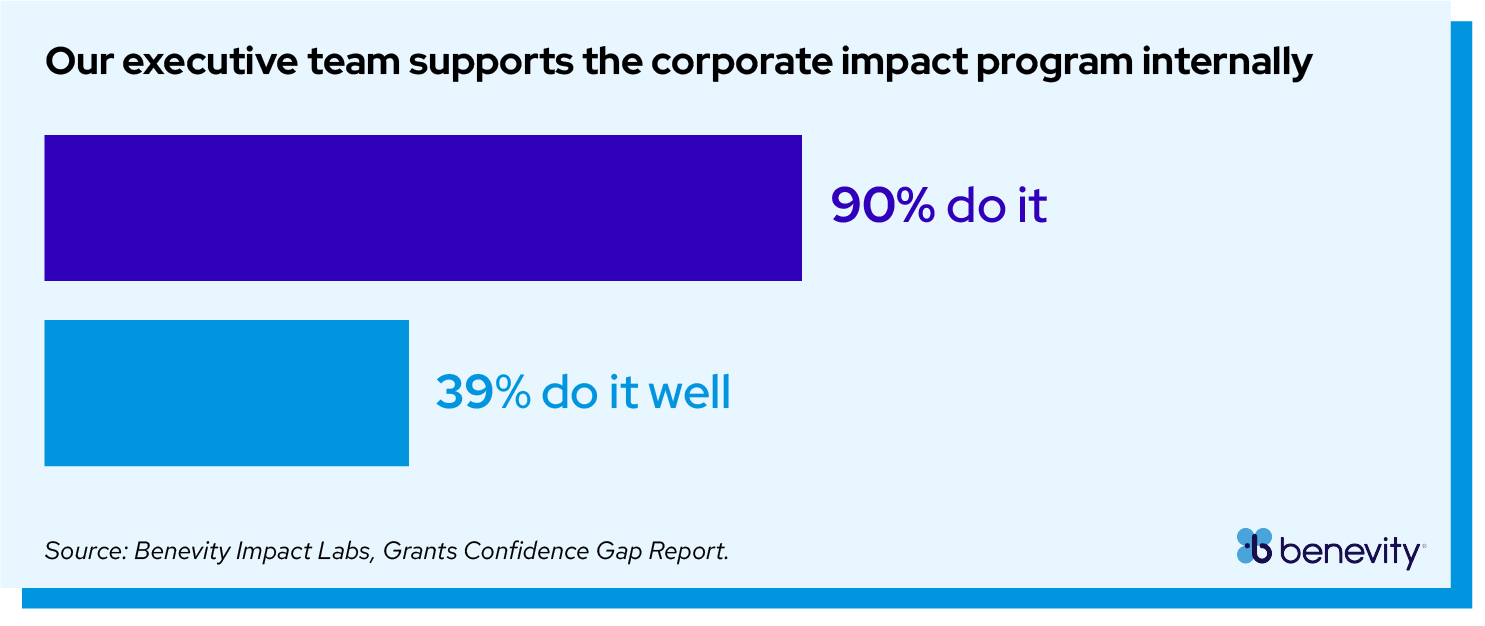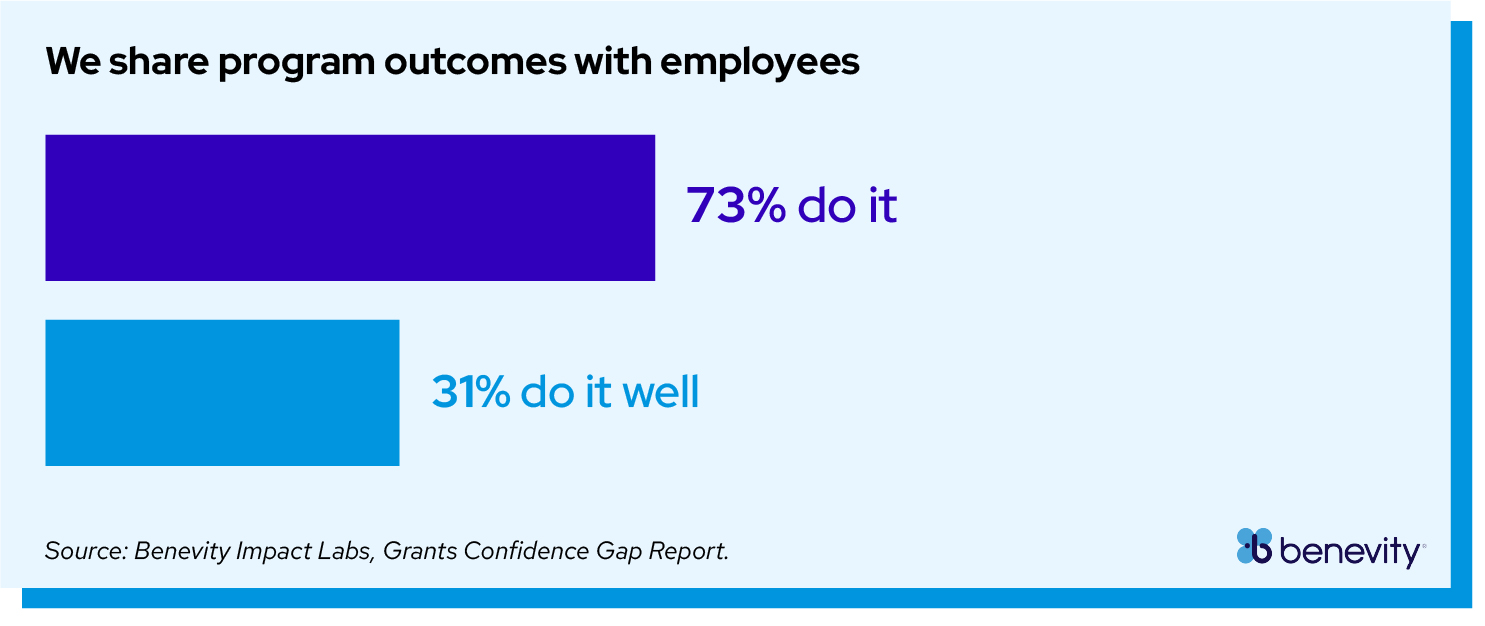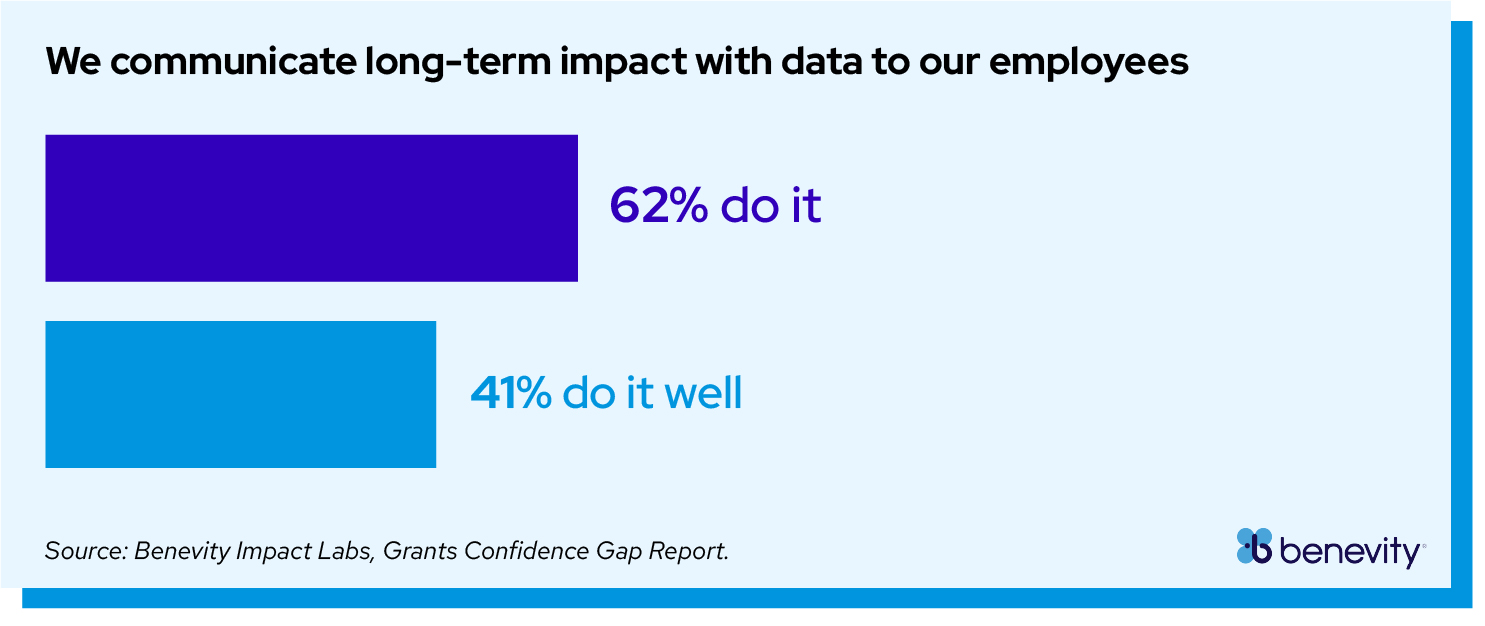Program officers and corporate grantmaking teams have incredible networks, connecting with nonprofits, communities, executives, employees, volunteers and peers. Managing granting programs requires being mindful of best practices while keeping all of these stakeholders informed amidst shifting expectations around transparency, alignment, success and scale. Through all of this, they remain active. In fact, 74% of grantmaking teams report that they are executing on best practices. But there’s a revealing insight alongside that — just 51% feel they are doing it well, suggesting there’s untapped potential to turn this activity into even stronger outcomes.
This gulf between what corporate grantmaking teams do and what they feel they do well is explored and analyzed in the new Benevity Impact Labs report, The Confidence Gap: Uncovering the Hidden Barriers to Effective Corporate Grantmaking. The report unpacks data from the Benevity Impact Index (BII), a proprietary self-assessment taken by 120 companies across 17 industries. The full assessment includes over 100 questions related to corporate impact programs. For the purposes of this report, we focused on 34 of those questions which relate directly to grantmaking practices.
Across the data, practices related to communication and stakeholder engagement revealed some of the lowest “do it well” scores, with many respondents reporting that they are not generating the kind of success they expect.
For these teams to close the confidence gap and realize more success in their communications, they must bring every stakeholder along on the journey of positive community impact, with the right information for the right audience at the right time. Communicating with executives is different from engaging employees, which itself is different from working with nonprofits, and so on.
Great communication means showing up with clarity, consistency and impact. So let’s take a look at the audiences that grantmaking teams engage with, what some of the gaps are, and how they can close the confidence gap in their communications.
Building executive support for grantmaking


Our data shows that 90% of organizations believe that executives support their programs internally, and 78% do so externally. When it comes to how effective grantmakers feel that support is, there’s a steep decline — just 39% and 23%, respectively.
These numbers suggest that CSR teams have less confidence in how executive support is showing up. Without confidence in that support, grantmakers may feel risk in their programs and question its place in strategic and budget priorities.
That’s why executive communication is a critical place for grantmaking teams to focus. Investments in consistent communication beyond facts and figures, including storytelling and connecting impact to business priorities, can help close that confidence gap.
Data-driven storytelling that shows how grantmaking ladders up to create positive outcomes for the business will not only build executive support, it will also help secure future budget and commitment to corporate impact programs overall. When executive support is stronger and more visible, and confidence among grantmaking teams grows, the ripple effects can be transformative.
Patagonia is an example of executive-led corporate impact. Their CSR initiatives are championed from the top, sending a clear signal across the organization and to external stakeholders.
How Rose Marcario, former CEO of Patagonia, believes that purpose drives business.
Bringing employees into grantmaking


Employee engagement is a challenging but meaningful best practice for successful corporate impact programs. When done well, engaged employees feel deeper ties to CSR, as well as their employers in general. But effective communication with employees means navigating cross-functional teams, finding the right messaging and proving the impact of the work.
To bolster the effectiveness of employee engagement, successful CSR practitioners are shifting from simply informing employees to actively engaging them. One way to do this is to involve employees and ERGs in the nomination and selection process. The communications around such opportunities can help amplify the grant program itself, while also engaging employees more deeply and creating conversations about granting at the employee and ERG level. Benevity data shows this is an underutilized practice, with just 54 percent allowing employee-nominated grants and 56% allowing ERG-directed funds.
This presents a great opportunity to bring employee voices into where and how a company gives. It reinforces a sense of purpose and invites employees to share ownership in a corporate impact program. It can also be a connecting thread between employee engagement and corporate strategy.

Building relationships with nonprofits
Effective communication with nonprofits can lead to years-long relationships, budget stability for corporate impact programs and even co-designed reporting metrics that help articulate CSR program success. Traditionally, nonprofits have been asked to fill out templated surveys or build structured reports based on predetermined corporate benchmarks. The biggest shift we’re seeing is companies evolving their definition of impact and embracing an open, collaborative dialogue with nonprofits to understand what impact means and how it’s reported.
Nonprofits are the ones with their boots on the ground, delivering the impact and seeing the positive outcomes in their communities. As the ones closest to the story, it’s critical to include them in building out communications.
The relationship between grantors and nonprofits goes well beyond storytelling. Collaborative, trusting relationships can be the catalyst that enhances an entire corporate impact program. CSR teams should seek the support and storytelling that can only come from their nonprofit partners and use it to present critical ideas and information back to their executives and employees, strengthening the relationship and the commitment to the grantee in the first place. It becomes a cyclical relationship where investment leads to positive outcomes, and those outcomes lead to more committed investment.
See how the Vanguard Group Foundation and the Free Library of Philadelphia Foundation go beyond funding and reporting.
Translating activity into storytelling
Many organizations are achieving more than they are being recognized for, because numbers alone don’t tell the full story. Typical grant program stats include dollars donated, nonprofits supported and volunteer hours logged, but these are just the inputs. To help build buy-in, support and strategic confidence in a grantmaking program, organizations must also tell stories around the outputs. Outputs can be some of the most difficult results to track, but provide some of the most meaningful insights into what your program is accomplishing. Things like the actual behavioral changes, environmental improvements, tangible community investments, or business improvements for your company.
This is where meaningful storytelling happens, and where the recognition for your program builds momentum. It helps create a shared understanding and allows everyone to see how their efforts are contributing to real change.
Tools like Benevity Reporting Studio and the beta version of a new feature — AI-generated grant summaries — can make it easier for CSR practitioners and their grantee partners to turn complex data into clear, compelling narratives. When data is combined with qualitative storytelling, impact becomes visible, not just measurable.
Communication isn’t just about telling your story. It’s about building confidence, securing resources and sustaining impact.
Strong communication practices help:
- Garner executive support
- Deepen employee engagement
- Strengthen nonprofit partnerships
- Prove the business case for sustained investment
If you are interested in learning more about the grants confidence gap and how CSR teams can leverage strong communication practices to help sustain and deepen grantmaking programs, read the full report here.









